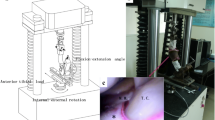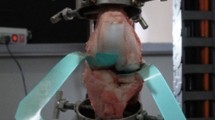Abstract
Introduction
Biodegradable implants are frequently used for meniscus repair. Articular cartilage damage has been reported recently after meniscus repair with biodegradable implants. The aim of the study was to investigate the meniscofemoral contact pressure at the posterior horn of the medial and lateral meniscus after repair of bucket-handle lacerations.
Materials and methods
Specimens were mounted in a materials testing machine (Bionix 858, MTS) which was equipped with a load cell. The quadriceps tendon was attached to a hydraulic cylinder, and knee motion was controlled via tension of the quadriceps tendon. A piezo-resistive system (Tekscan, Boston, MA, USA) measured the meniscofemoral contact pressure. Five different types of biodegradable implants (Arrow, Dart, Fastener, Stinger and Meniscal Screw) and horizontal suture (no. 2 Ethibond) were tested. The knee was extended from 90° of flexion to 0° under a constant load of 350 N due to adjustment of the tension force of the quadriceps tendon. The femorotibial pressure and contact area were recorded at 0°, 30°, 60° and 90° of flexion.
Results
The meniscofemoral pressure did not increase after meniscus repair with biodegradable implants or sutures. The meniscofemoral peak pressure at the posterior horn was 1.46±1.54 MPa in the medial compartment and 1.08±1.17 MPa in the lateral compartment at full knee extension. The meniscofemoral pressure increased significantly in both compartments with knee flexion from 0° to 90°.
Conclusion
Biodegradable implants for meniscus repair do not affect the meniscofemoral pressure. However, there remains a risk of damage to the cartilage when barbed implants are used. If the implant is not entirely advanced into the meniscus, the sharp head or some of the barbs at the column of the implant may come into direct contact with the articular cartilage of the femoral condyle or tibial plateau. The authors presume that incorrect positioning of the implant seems to be the major reason for cartilage damage.



Similar content being viewed by others
References
Aagaard H, Verdonk R (1999) Function of the normal meniscus and consequences of meniscal resection. Scand J Med Sci Sports 9:134–140
Ahmed AM (1983) A pressure distribution transducer for in-vitro static measurements in synovial joints. J Biomech Eng 105:309–314
Allen CR, Wong EK, Livesay GA, Sakane M, Fu FH, Woo SL (2000) Importance of the medial meniscus in the anterior cruciate ligament-deficient knee. J Orthop Res 18:109–115
Anderson K, Marx RG, Hannafin J, Warren RF (2000) Chondral injury following meniscal repair with a biodegradable implant. Arthroscopy 16:749–753
Aspden RM, Yarker YE, Hukins DW (1985) Collagen orientations in the meniscus of the knee joint. J Anat 140:371–380
Barber FA, Herbert MA (2000) Meniscal repair devices. Arthroscopy 16:613–618
Bargar WL, Moreland JR, Markolf KL, Shoemaker SC, Amstutz HC, Grant TT (1980) In vivo stability testing of post-meniscectomy knees. Clin Orthop 150:247–252
Becker R, Schroder M, Starke C, Urbach D, Nebelung W (2001) Biomechanical investigations of different meniscal repair implants in comparison with horizontal sutures on human meniscus. Arthroscopy 17:439–444
Becker R, Starke C, Heymann M, Nebelung W (2002) Biomechanical properties under cyclic loading of seven meniscus repair techniques. Clin Orthop 400:236–245
Becker R, Voigt D, Starke C, Heymann M, Wilson GA, Nebelung W (2001) Biomechanical properties of quadruple tendon and patellar tendon femoral fixation techniques. Knee Surg Sports Traumatol Arthrosc 9:337–342
Favenesi J, Shaffer J, Mow VC (1983) Biphasic mechanical properties of knee meniscus. Orthop Trans 8:174
Felson DT, Naimark A, Anderson J, Kazis L, Castelli W, Meenan RF (1987) The prevalence of knee osteoarthritis in the elderly. The Framingham Osteoarthritis Study. Arthritis Rheum 30:914–918
Fithian DC, Kelly MA, Mow VC (1990) Material properties and structure-function relationships in the menisci. Clin Orthop 252:19–31
Fukubayashi T, Kurosawa H (1980) The contact area and pressure distribution pattern of the knee. A study of normal and osteoarthrotic knee joints. Acta Orthop Scand 51:871–879
Goertzen DJ, Budney DR, Cinats JG (1997) Methodology and apparatus to determine material properties of the knee joint meniscus. Med Eng Phys 19:412–419
Harris ML, Morberg P, Bruce WJ, Walsh WR (1999) An improved method for measuring tibiofemoral contact areas in total knee arthroplasty: a comparison of K-scan sensor and Fuji film. J Biomech 32:951–958
Higuchi H, Kimura M, Shirakura K, Terauchi M, Takagishi K (2000) Factors affecting long-term results after arthroscopic partial meniscectomy. Clin Orthop 377:161–168
Hsieh HH, Walker PS (1976) Stabilizing mechanisms of the loaded and unloaded knee joint. J Bone Joint Surg Am 58:87–93
Kohn D, Mussack T, Plitz W (1993) Material properties of meniscus tissue and the effect of the menisci on the compression behavior of the knee joint. Z Orthop 131:397–403
Kohn D, Siebert W (1989) Meniscus suture techniques: a comparative biomechanical cadaver study. Arthroscopy 5:324–327
Lanzer WL, Komenda G (1990) Changes in articular cartilage after meniscectomy. Clin Orthop 252:41–48
Lechner K, Hull ML, Howell SM (2000) Is the circumferential tensile modulus within a human medial meniscus affected by the test sample location and cross-sectional area? J Orthop Res 18:945–951
Levy IM, Torzilli PA, Warren RF (1982) The effect of medial meniscectomy on anterior-posterior motion of the knee. J Bone Joint Surg Am 64:883–888
Messner K, Gao J (1998) The menisci of the knee joint. Anatomical and functional characteristics, and a rationale for clinical treatment. J Anat 193:161–178
Morgan CD (1991) The ‘all-inside’ meniscus repair. Arthroscopy 7:120–125
Mow V, Ratcliffe A, Chern K, Kelly M (1992) Structure and function relationships of the menisci of the knee. In: Mow V, Arnoczky SP, Jackson DW (eds) Knee meniscus: basic and clinical foundations. Raven Press, New York, pp 37–53
Neyret P, Donell ST, DeJour D, DeJour H (1993) Partial meniscectomy and anterior cruciate ligament rupture in soccer players. A study with a minimum 20-year followup. Am J Sports Med 21:455–460
Paletta GAJ, Manning T, Snell E, Parker R, Bergfeld J (1997) The effect of allograft meniscal replacement on intraarticular contact area and pressures in the human knee. A biomechanical study. Am J Sports Med 25:692–698
Petersen W, Tillmann B (1999) Structure and vascularization of the knee joint menisci. Z Orthop 137:31–37
Proctor CS, Schmidt MB, Whipple RR, Kelly MA, Mow VC (1989) Material properties of the normal medial bovine meniscus. J Orthop Res 7:771–782
Rockborn P, Gillquist J (1996) Long-term results after arthroscopic meniscectomy. The role of preexisting cartilage fibrillation in a 13 year follow-up of 60 patients. Int J Sports Med 17:608–613
Ross G, Grabill J, McDevitt E (2000) Chondral injury after meniscal repair with bioabsorbable arrows. Arthroscopy 16:754–756
Schatzmann L, Brunner P, Staubli HU (1998) Effect of cyclic preconditioning on the tensile properties of human quadriceps tendons and patellar ligaments. Knee Surg Sports Traumatol Arthrosc 6 [Suppl 1]:S56–61
Seil R, Rupp S, Mai C, Kohn D (2001) The footprint of meniscus fixation devices on the femoral surface of the medial meniscus: a biomechanical cadaver study. 3rd ISAKOS Congress, Montreaux, Switzerland, May 14–18, poster no. 400
Seil R, Rupp S, Dienst M, Mueller B, Bonkhoff H, Kohn DM (2000) Chondral lesions after arthroscopic meniscus repair using meniscus arrows. Arthroscopy 16:E17
Shoemaker SC, Markolf KL (1982) In vivo rotatory knee stability. Ligamentous and muscular contributions. J Bone Joint Surg Am 64:208–216
Skaggs DL, Warden WH, Mow VC (1994) Radial tie fibers influence the tensile properties of the bovine medial meniscus. J Orthop Res 12:176–185
Spilker RL, Donzelli PS, Mow VC (1992) A transversely isotropic biphasic finite element model of the meniscus. J Biomech 25:1027–1045
Tekscan (2001) Tekscan product information—medical product overview. Tekscan, Boston
Tissakht M, Ahmed AM (1995) Tensile stress-strain characteristics of the human meniscal material. J Biomech 28:411–422
Walker PS, Erkman MJ (1975) The role of the menisci in force transmission across the knee. Clin Orthop 109:184–192
Wirz D, Becker R, Li SF, Friederich NF, Muller W (2002) Validation of the Tekscan system for statistic and dynamic pressure measurements of the human femorotibial joint. Biomed Tech (Berl) 47:195–201
Acknowledgement
We received financial support from the Arbeitsgemeinschaft für Arthroskopie (AGA) for this study.
Author information
Authors and Affiliations
Corresponding author
Rights and permissions
About this article
Cite this article
Becker, R., Wirz, D., Wolf, C. et al. Measurement of meniscofemoral contact pressure after repair of bucket-handle tears with biodegradable implants. Arch Orthop Trauma Surg 125, 254–260 (2005). https://doi.org/10.1007/s00402-004-0739-5
Received:
Published:
Issue Date:
DOI: https://doi.org/10.1007/s00402-004-0739-5




